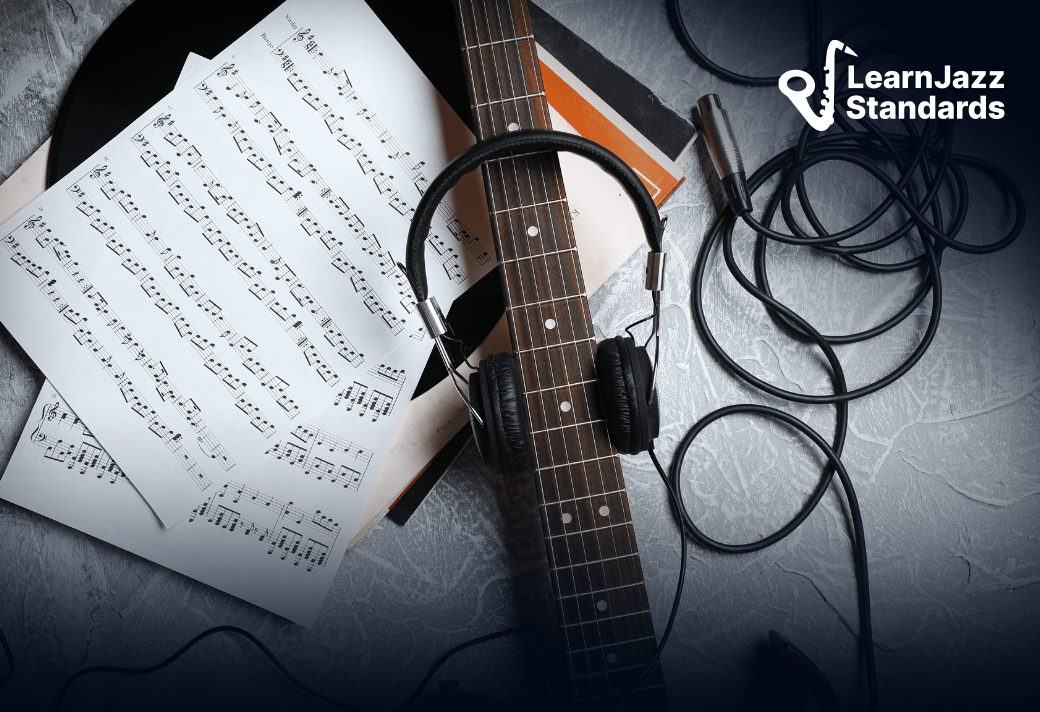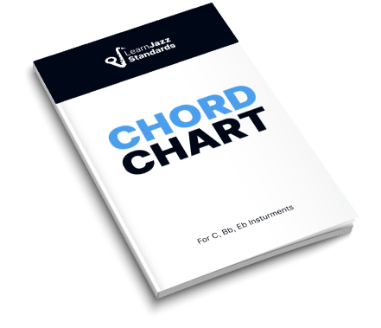The melodic minor scale is one of the most important and useful scales you can master.
Yes, you should know your major scale and its modes, but the major scale and other derived scales, like the natural minor scale, don’t cover all sounds found in jazz music.
To access those jazzier sounds while improvising, you’ll need to learn the melodic minor scale (also known as the jazz minor scale) and all its modes.
In this post, we will go over all the melodic minor scale modes and discuss how you can use them to supercharge your jazz improvisation skills.
If you are ready to take the next step in your jazz development and want to learn how to use melodic minor scales and other important jazz scales to supercharge your playing, then check out the Learn Jazz Standards Inner Circle.
When you join the Inner Circle, you’ll gain access to a treasure trove of jazz education resources—from workshops, masterclasses, jazz standard deep dives, and invaluable courses—all designed by jazz professionals to help you become the best player you can be.
Ready to take your jazz playing to the next level? See what the Inner Circle is all about!
Table of Contents
Melodic Minor Scales Overview
Some of you may have taken a music theory course that discussed the melodic minor scale in the classical sense. In classical music theory, the melodic minor scale changes depending on whether or not you are ascending or descending. Therefore, it has two forms.
Ascending Melodic Minor Scale
When ascending the melodic minor scale, the sixth and seventh degrees are raised when compared to the natural minor scale. On the way up the scale, the sixth degree is a major sixth interval above the scale’s root, and the seventh degree is a major seventh interval above the root.

The ascending melodic minor scale formula is:
- (W)-(H)-(W)-(W)-(W)-(W)-(H)
- C-D-Eb-F-G-A-B-C
- Rt-M2 m3-P4-P5-M6-M7
Descending Melodic Minor Scale
When descending the melodic minor scale in classical music, you’ll lower the sixth and seventh scale degrees. The descending melodic minor scale has the same notes as a basic natural minor scale. The sixth scale degree is a minor sixth interval above the root, and the seventh scale degree is a minor 7th interval above the root.

The descending melodic minor scale formula is:
- Descending: (W)-(W)-(H)-(W)-(W)-(H)-(W)
- C-Bb-Ab-G-F-Eb-D-C
- Rt-m7-m6-5-4-m3-2-Rt
The idea behind having a different ascending and descending scale is to create a sense of levity on the way up and a sense of gravity on the way down.
- The ascending version has a lighter feel due to the raised 6th and raised 7th scale degrees.
- The descending version feels heavier due to lowered 6th and lowered 7th scale degrees.
This can enhance the emotional experience of the music.
But What About Jazz?
However, for jazz musicians, the melodic minor scale is just the ascending version of the “classical” melodic minor scale.
We don’t picture this scale as having different ascending and descending versions. Jazz musicians are more concerned with pitch environments or collections of pitches that create a specific sound. We see the ascending form and descending form as different because they make two different pitch environments:
- One is the melodic minor scale (raised sixth and seventh)
- The other is just the natural minor scale (the sixth mode of the major scale)
Some ways to think about the melodic minor scale:
When learning music, having a few ways of thinking about a concept is useful. There are a few ways you can use scales you already know to help you remember other scales.
You can think of the melodic minor scale in two ways:
- Major Scale with a minor third scale degree
- Natural Minor Scale with major sixth and major seventh
Modes of the Melodic Minor Scale
Just like the major scale, the melodic minor scale has seven modes. Each note in the melodic minor scale can be a root in its own scale. Though the sequence of notes is the same, what we consider the root note changes depending on the mode.
For example, the sequence of notes in the C major scale is:
- C-D-E-F-G-A-B-C
However, we don’t have to start on C. Let’s change the root note to E but keep the same sequence:
- E-F-G-A-B-C-D-E
As long as we maintain the sequence of notes, the mode will change, but the relationships between the notes remain intact.

For a refresher on the major scale modes, check out this guide to the major scale modes.
The same reasoning applies to the melodic minor scale.
Within a C melodic minor scale, there are six other scales. Many of these scales are vitally important to the jazz sound! In the following section, we will go over vital information you need to know about all seven of the melodic minor modes and associated melodic minor chords.
Note that you’ll see both the “correct” mode name and what the scale is more commonly called in the sections below. Classifying things can get tricky, especially when focusing on the details. The “correct” mode name is the most “technically accurate way” to refer to a scale, but this can lead to confusion. In practice, you’ll almost always use the common name when referring to these scales.
First Mode: C Melodic Minor Scale

- Mode Position: C melodic minor: “Parent” scale/mode or “root mode”
- Scale Spelling: C-D-Eb-F-G-A-B-C
- “Correct” Mode Name: Dorian Natural 7
- Commonly Called: The Melodic Minor Scale
- 7th Chord: C-(maj7)
- Related Major Mode: Dorian
Second Mode: Dorian Flat 2

- Mode Position: C melodic minor played from D
- Scale Spelling: D-Eb-F-G-A-B-C-D
- “Correct” Mode Name: Phrygian natural 6
- Commonly Called: Dorian Flat 2
- 7th Chord: D-7
- Related Major Mode: Phrygian
Third Mode: Lydian Augmented

- Mode Position: C melodic minor played from Eb
- Scale Spelling: Eb-F-G-A-B-C-D-Eb
- “Correct” Mode Name: Lydian Sharp 5
- Commonly Called: Lydian Augmented
- 7th Chord: Ebmaj7(#5)
- Related Major Mode: Lydian
Fourth Mode: Lydian Dominant

- Mode Position: C melodic minor played from F
- Scale Spelling: F-G-A-B-C-D-Eb-F
- “Correct” Mode Name: Mixolydian Sharp 4
- Commonly Called: Lydian Dominant
- 7th Chord: F7 (especially F7#11)
- Related Major Mode: Mixolydian
Fifth Mode: Mixolydian Flat 6

- Mode Position: C melodic minor played from G
- Scale Spelling: G-A-B-C-D-Eb-F-G
- “Correct” Mode Name: Aeolian Natural 3
- Commonly Called: Mixolydian Flat 6
- 7th Chord: G7 (especially G7b13)
- Related Major Mode: Aeolian
Sixth Mode: Locrian Natural 2

- Mode Position: C melodic minor played from A
- Scale Spelling: A-B-C-D-Eb-F-G-A
- “Correct” Mode Name: Locrian Natural 2
- Commonly Called: Locrian Natural 2, or “Minor 7 flat 5” or “Aeolian flat 5”
- 7th Chord: A-7b5
- Related Major Mode: Locrian
Seventh Mode: Super Locrian or Altered Scale

- Mode Position: C melodic minor played from B
- Scale Spelling: B-C-D-Eb-F-G-A-B
- “Correct” Mode Name: Ionian Sharp 1
- Commonly Called: The Altered Scale, Super Locrian, or Diminished whole-tone
- 7th Chord: B-7b5
- Related Major Mode: Ionian
BEFORE YOU CONTINUE...
If you struggle to play amazing jazz solos and want to learn the secret strategies the pros are using to improvise, our free guide will get you on the right track.

Melodic Minor Chord Scales (Seventh Chords)

Notice how a melodic minor chord scale differs from chord scales built from natural minor scales:
Here is a natural minor scale harmonized in seventh chords (note how Roman numerals change between major and minor keys):

The chords are:
- VII: C7
- VI: Bbmaj7
- v: A-7
- vi: G-7
- III: Fmaj7
- iiø: E-7b5
- i: D-7
Here is a D melodic minor scale harmonized in seventh chords. Notice how the raised sixth and seventh scale degrees change the characteristics of the seventh chords in the chord scale.

- viiø: C#-7b5
- viø: B-7b5
- V: A7
- IV: G7
- III: Fmaj7#5
- ii: E-7
- i: D-(maj7)
Ways To Apply The Melodic Minor Scale Over Tunes
The melodic minor sound is really useful over altered dominant chords. In the following exercise, we’ll play a melodic minor lick over different pitch environments from real jazz standards.
In the list below, you’ll find backing tracks where you can use this melodic minor lick in other contexts and over different chord progressions.

- Solar: Try this lick over the C-(maj7) chord in Solar to hear the Melodic Minor Scale.
- Caravan: To hear Dorian Flat 2, transpose this lick to Bb melodic minor (whole step down), then try it over Caravan.
- Dolphin Dance: To hear Lydian Augmented, transpose this lick up a perfect fourth to F melodic minor, then try it over the Abmaj7(#5) chord in Dolphin Dance.
- Stella by Starlight: To hear Lydian Dominant, transpose this to Eb melodic minor and use it over the Ab7(#11) chord in Stella By Starlight.
- Stella By Starlight: To hear Mixolydian b6, bring this lick back to C melodic minor and play it over the G7(b13) at the beginning of the bridge.
- I Love You: To hear Locrian Flat 2, keep the lick in C melodic minor and play it over the A-7(b5) chord.
- My One and Only Love: To hear the Altered Scale, use this lick over any B7(alt.) chord.
For a melodic minor scale summary and a deeper look at the modes of the melodic minor scale, check out Four Modes of the Melodic Minor Scale To Take Your Jazz Playing To The Next Level.
The Harmonic Minor Scale: The Other Minor Scale You Need To Check Out
You already know the natural minor scale, and now you know the melodic minor scale. However, there is another minor scale you need to check out next on your journey toward jazz mastery: the harmonic minor scale.
The harmonic minor scale keeps the major seventh scale degree found in melodic minor scales but has the minor sixth degree also found in natural minor scales. This creates a wider interval between the 6th and 7th degrees than found in other minor scales.
Here is an E natural minor scale compared with its melodic and harmonic minor counterparts:

The melodic minor scale has the raised sixth and seventh degrees:

However, the harmonic minor scale has a minor 6th interval which creates a minor third between the 6th and 7th scale degrees:

Like the melodic minor scale, the harmonic minor scale has its own modes and special applications. To learn more about harmonic minor scales, check out how to use them over ii-V-i chord progressions.
Supercharge Your Jazz Chops! Join The Learn Jazz Standards Inner Circle
Are you ready to take your jazz playing and improv chops to the next level but unsure how to get there? If this sounds like you, then you need to check out all that the Learn Jazz Standards Inner Circle has to offer.
The Inner Circle offers a proven, effective, and fun way to build your jazz chops, tune repertoire, and theory knowledge. Through masterclasses, workshops, live streams, and various courses, you’ll access the knowledge you need and learn the process that will help you become the best jazz player you can be.









